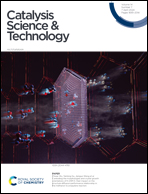Bimetallic platinum rhenium catalyst for efficient low temperature dehydrogenation of perhydro benzyltoluene†
Abstract
Benzyltoluene (H0-BT) is a promising liquid organic hydrogen carrier (LOHC) molecule. Catalytic hydrogenation of H0-BT to perhydro benzyltoluene (H12-BT) and dehydrogenation back to H0-BT to release the chemically bound hydrogen constitute a suitable and technically relevant hydrogen storage cycle. Herein, we report the development of a bimetallic Pt–Re/Al2O3 catalyst for the dehydrogenation of H12-BT under moderate conditions to enable heat integration of the endothermal dehydrogenation reaction with low temperature waste heat streams. The reducibility of the catalyst is compared to a monometallic Pt/Al2O3 reference system using temperature-programmed reduction (TPR) and in situ reduction during X-ray absorption spectroscopy (XAS) to gain insight on the mode of interaction between Pt and Re. TPR and XAS propose full reduction of Pt, while rhenium oxide is only partially reduced at 400 °C. Analysis by means of extended X-ray absorption fine structure suggests a lower coordination number and thus smaller entities of Pt for bimetallic catalysts with increasing Re loading. Further, an electronic modification of Pt is observed, which mostly stems from residual Cl-species from the Pt-precursor, but may also indicate direct interaction with Re. Structural promotion of Pt by Re provided a strong stabilization of smaller clusters and nanoparticles leading to a high Pt dispersion even during catalyst activation in H2 at high temperatures of 700 °C. When compared to the monometallic reference, particularly the initial hydrogen release is accelerated when using Pt–Re/Al2O3 catalysts. Mechanistically, the bimetallic catalysts outperformed the monometallic reference catalyst due to an efficient initial dehydrogenation of H12-BT and a short lifetime of the partially dehydrogenated intermediate (H6-BT) yielding H0-BT as the desired product of the consecutive reaction. The catalytic performance and XAS studies suggest an optimized structural composition of the active Pt phase, potentially via an ensemble effect, which allows for efficient H2 release from H12-BT.



 Please wait while we load your content...
Please wait while we load your content...